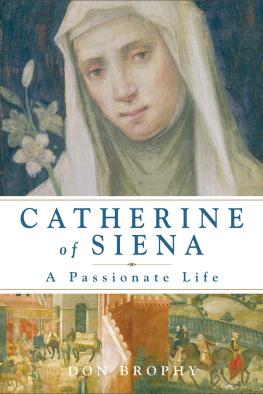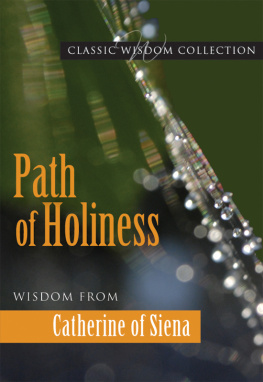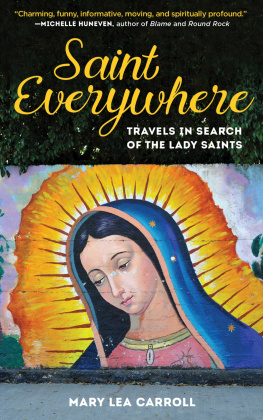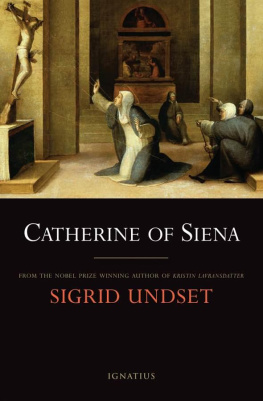Don Brophy - Catherine of Siena: A Passionate Life
Here you can read online Don Brophy - Catherine of Siena: A Passionate Life full text of the book (entire story) in english for free. Download pdf and epub, get meaning, cover and reviews about this ebook. year: 2010, publisher: BlueBridge, genre: Non-fiction. Description of the work, (preface) as well as reviews are available. Best literature library LitArk.com created for fans of good reading and offers a wide selection of genres:
Romance novel
Science fiction
Adventure
Detective
Science
History
Home and family
Prose
Art
Politics
Computer
Non-fiction
Religion
Business
Children
Humor
Choose a favorite category and find really read worthwhile books. Enjoy immersion in the world of imagination, feel the emotions of the characters or learn something new for yourself, make an fascinating discovery.
- Book:Catherine of Siena: A Passionate Life
- Author:
- Publisher:BlueBridge
- Genre:
- Year:2010
- Rating:3 / 5
- Favourites:Add to favourites
- Your mark:
- 60
- 1
- 2
- 3
- 4
- 5
Catherine of Siena: A Passionate Life: summary, description and annotation
We offer to read an annotation, description, summary or preface (depends on what the author of the book "Catherine of Siena: A Passionate Life" wrote himself). If you haven't found the necessary information about the book — write in the comments, we will try to find it.
This biography of the great mystic and saint Catherine of Siena presents a moving, lucid portrait of the strong-minded and fiery young woman who campaigned for peace and struggled to reform the church during the turbulent 14th century, and became one of our most beloved spiritual figures.
Catherine of Siena: A Passionate Life — read online for free the complete book (whole text) full work
Below is the text of the book, divided by pages. System saving the place of the last page read, allows you to conveniently read the book "Catherine of Siena: A Passionate Life" online for free, without having to search again every time where you left off. Put a bookmark, and you can go to the page where you finished reading at any time.
Font size:
Interval:
Bookmark:


Catherine of Siena by Andrea Vanni

Copyright 2010 by Donald Brophy
All rights reserved. No part of this book may be reproduced or transmitted in any form or by any means, electronic or mechanical, including photocopying, recording, or by any information storage and retrieval system, without permission in writing from the Publisher.
Selections from the four volumes of The Letters of Catherine of Siena, translated and edited by Suzanne Noffke, copyright Arizona Board of Regents for Arizona State University, are reprinted with permission. Selections from Catherine of Siena: The Dialogue, translation and introduction by Suzanne Noffke, copyright 1980 by Paulist Press, Inc., New York/Mahwah, NJ, are reprinted by permission of Paulist Press, Inc., www.paulistpress.com. Selections from The Prayers of Catherine of Siena, edited and translated by Suzanne Noffke, are reprinted by permission of Suzanne Noffke. The excerpt from Canzoniere 114 by Francesco Petrarch, translated by A. S. Kline, is reprinted by permission of A. S. Kline, Poetry in Translation, www.tonykline.co.uk. Excerpts from The Life of Catherine of Siena by Raymond of Capua, translated by Conleth Kearns, OP, are reprinted by permission of Dominican Publications, www.DominicanPublications.com. Scripture quotations are from the New Revised Standard Version Bible, copyright 1989 by the Division of Christian Education of the National Council of Churches of Christ in the United States of America. All rights reserved.
Published by
BlueBridge
An imprint of
United Tribes Media Inc.
www.bluebridgebooks.com
L IBRARY OF C ONGRESS C ATALOGING-IN- P UBLICATION D ATA
Brophy, Donald, 1934-
Catherine of Siena : a passionate life / Don Brophy.
p. cm.
Includes bibliographical references (p. ) and index.
ISBN 978-1-933346-28-1
1. Catherine, of Siena, Saint, 1347-1380. 2. Christian saintsItalyBiography. I. Title.
BX4700.C4B76 2010
282.092dc22
[B] 2010012302
Jacket design by Stefan Killen Design
Cover art top: Fra Bartolommeo (Baccio della Porta) (14721517), St. Catherine of Siena, Museo di S. Marco, Florence. Photo credit: Finsiel/Alinari / Art Resource, NY
Cover art bottom: Ambrogio Lorenzetti (d. c.1348), Effects of Good Government (1338). Palazzo Pubblico, Siena. Photo credit: Erich Lessing / Art Resource, NY
Image on page : Andrea Vanni, St. Catherine of Siena, San Domenico, Siena.
Photo credit: Scala / Art Resource, NY
Text design by Cynthia Dunne
Map by Chris Erichsen
Printed in the United States of America
10 9 8 7 6 5 4 3 2 1


PART ONE


I n the first light of day the rooftops of Siena gradually turned from black shapes into brown and then, as the sky lightened, began to glow a deep amber-red, strewn across three knobs of hills like a banked fire of coals. Viewed from the top of the soaring Torre del Mangia, nearly completed in the center of town, the contours of the walled city began to fall into place, a profile pierced by a multitude of towers, leaving pools of darkness where narrow valleys lay between the hilltops. Slowly the March light inched from roof tiles to the brick facades of dwellings whose shutters, one by one, winked open to the new day. Somewhere a rooster crowed, dogs barked. From scattered neighborhoods church bells proclaimed a time for prayer. Sequestered in convents around the city monks and nuns had been awake for hours, leaving their pallets while it was still dark to ask Gods blessing on this day and on the world, their voices joined in a wavering chant:
A solis ortu usque ad occasum,
laudabile nomen Domini.
[From sunrise to sunset,
may the name of the Lord be praised.]
In front of the handsome Palazzo Pubblico, Sienas government building, night shadows pulled back to reveal the great fan-shaped Campo, newly paved with brick and stone, which served as the citys main square and civic center. Already men and women could be seen strolling into its wide open space from the warren of streets that bound it on all sides. Deliberately the people began their routine of setting up stalls and opening shops. In this medieval city, the day began early. Farther away, along the fringes of the encircling walls, gates creaked open to admit oxcarts laden with produce from the countryside, the fertile Sienese contado. Entering through the Camollia gate in the northern wall were a few pilgrims who had trekked from Lombardy or from countries beyond the Alps and who would make Siena a stopover on their way to Rome. This was a special day for pilgrims and city dwellers alike: March 25. It was the Feast of the Incarnation, when the faithful recalled how God had cast his lot with the human race, taking on the vulnerability of ordinary flesh. In this particular year, March 25 was also Palm Sunday, the beginning of Holy Week. Preparations were already under way to mark the day with great solemnity in the duomo, the magnificent cathedral built of white and black marble a short distance from the Campo. The day was special, too, because for Siena, as for the other city-states of Tuscany, March 25 marked the beginning of the new year: 1347.
This new year found Siena at peace with its neighbors and still close to the peak of its influence and wealth. Siena was one of the cities thaton the surface at leastwere giving new shape to the possibilities of urban life in the late Middle Ages. The cities of northern Europe were mostly dirty, disease-ridden, and controlled either by hereditary monarchs or families of nobles who lived outside the walls on feudal estates. To the south, the great city of Rome was languishing, its public monuments crumbling. But in Tuscany nearly all of the cities were self-governing states whose lawmakers were elected and whose leadership was in the hands of the merchant class. Their economy was no longer founded on agriculture but on trade and finished goodsand one thing more, on money. Tuscan cities, especially Florence and to a lesser degree Siena, had become the bankers of Europe. The gold florin minted in Florence was Europes most trusted currency. With a population of almost 50,000, Siena was nearly bursting at the seams. Six times during the Middle Agesincluding twice in the last two dozen yearsSienas walls had to be extended to enclose larger areas. The increasing population did not come from a rising birthrate, however; due to the state of public health in the fourteenth century, sickness and death in cities always exceeded new births. Instead, Siena grew by attracting people from the region under its control, which included numerous villages and some larger towns to the south and west. Each of the Italian city-states tried to control its immediate region as a way of keeping itself supplied with food and labor, and the collision of cities bent on expanding their territories had given rise to a series of bloody little wars. Florence and Siena, abutting each others territories, were hereditary rivals. After a Sienese alliance defeated the Florentines in the Battle of Montaperti in 1260, Siena was briefly the dominant power in the region. Unfortunately for Siena it was very briefly: Florence came back only nine years later and annihilated the Sienese at Colle di Val dElsa. By 1347 Siena had accepted Florentine hegemony but remained fiercely independent in spirit.
Next pageFont size:
Interval:
Bookmark:
Similar books «Catherine of Siena: A Passionate Life»
Look at similar books to Catherine of Siena: A Passionate Life. We have selected literature similar in name and meaning in the hope of providing readers with more options to find new, interesting, not yet read works.
Discussion, reviews of the book Catherine of Siena: A Passionate Life and just readers' own opinions. Leave your comments, write what you think about the work, its meaning or the main characters. Specify what exactly you liked and what you didn't like, and why you think so.









